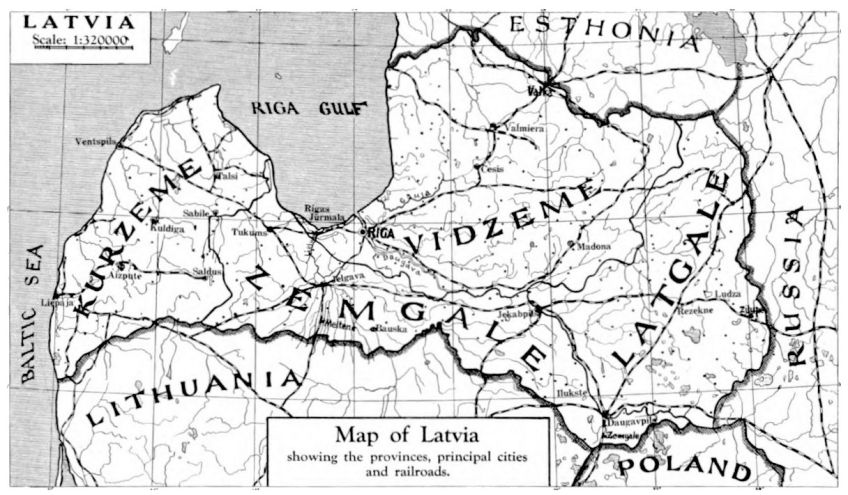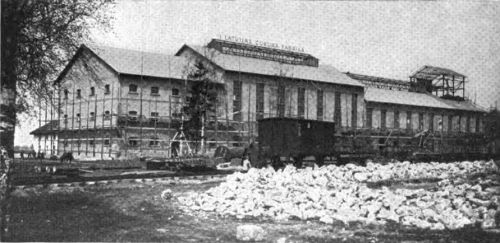EFFECTS OF THE WAR AND RECONSTRUCTION ON LATVIAN AGRICULTURE AND ITS PRESENT ECONOMIC SITUATIONCompiled from the Latvian Economist for Jan.-Feb., 1927 and from Latvia's Report to the 1927 International Economic Conference at Geneva
THE effects of the World War on Latvia were particularly disastrous in the decrease of her population (from 2,550,000 in 1914 to in 1920); the complete destruction of her manufacturing (owing to the removal, by Russian military orders, of the principal industrial undertakin5 to the interior of Russia); the depreciation of her currency; the cutting off of her transit trade (for the Baltic ports had been the avenues of communication with interior Russia); and the loss of her former Russian markets. Furthermore, fighting on Latvian soil continued more than a year after the Armistice of 1918 and it was not until 1920 that any real progress toward reconstruction could be begun. Local agriculture, particularly livestock breeding, was, during five years, most seriously damaged; 25% of all rural buildings were destroyed; cultivation was reduced by 40%. The differences in the areas sown to the principal crops during the years before the War, the year following its conclusion and again after five years of peace and reconstruction, are significant:
Areas (in hectares) planted to the principal Latvian crops
| 1909- 1913 | 1920 | 1925 | 1926 | |
| Rye | 350,800 | 196,600 | 266,500 | 251,300 |
| Wheat | 32,600 | 15,800 | 48,100 | 49,500 |
| Barley | 191,000 | 123,800 | 176,600 | 190,300 |
| Oats | 305,900 | 215,600 | 334,300 | 320,800 |
| Peas | 23,300 | 20,100 | . . . . . . | 38.200 |
| Potatoes | 79,600 | 49,200 | 74,900 | 82,100 |
| Flax | 69,600 | 30,500 | 78,100 | 63,800 |
Although grain-raising (with the exception of rye), has now attained or passed the pre-war level, the amount of wheat and rye raised in Latvia is not (and never has been, even before the War) sufficient to meet the needs of the population. Latvia imports every year approximately 60,000 tons of rye and 45,000 tons of wheat. Sugar and herring are the other chief items in her food imports, and she also imports artificial manures, agricultural machinery and raw materials (hides, animal fats, etc.), naphtha, cement, oil-seeds and rubber.
The area under rye decreased in 1926 by about 15,000 hectares as compared with the preceding year. This decrease may be explained partly by the excessive rains in the autumn of 1925, but partly also by the farmers' preference for wheat, which in the matter of income tax is more profitable. The increase of the total area under wheat is, however, only 1,400 hectares, this being far behind the decline in the area of rye.
The area under flax also declined considerably—from 78,100 hectares in 1925 to 63,800 hectares in 1926. In 1925 the area of flax exceeded the pre-war area by 12.2%. but in 1926 it was considerably lower than before the War. The decline relates mainly to the provinces of Kurzeme, Zemgale, and Vidzeme, as Latgale (see map) remained true to flax cultivation. Flax was heretofore the main source of income to the farmers of Vidzeme and Latgale, but its cultivation requires much work. In Vidzeme, where the farms are bigger and labor must be hired, the cultivation of flax becomes difficult. Therefore, farmers begin to give up flax, and turn their attention more to cattle-breeding. In the smaller agricultural units of Latgale, where the owners usually work the soil themselves, the cultivation of flax continues to be important, but it is to be expected that Latgale, too, will in future pay more attention to cattle-breeding.

The territory of Latvia comprises the former Bussian province of Courland, together with parts of Livonia, Vitebsk, Kovno and Pskov. Its boundaries coincide with ethnographical boundaries of the territory occupied by Latvians (or Letts). Its independence was declared Nov. 18, 1918, and the Republic became a member of the Leaguø of Nations Sept. 22. 1921. With an area of 65,791.4 square kilometers (about 25,000 square miles), Latvia equals the combined areas of Vermont, Massachusetts, Connecticut and Rhode Island. It is larger than Denmark, Switzerland, Holland, Belgium or Albania and not much smaller than Hungary or Austria. It is slightly larger than Esthonia, its neighbor on the north, and a little smaller than Lithuania, its neighbor on the south. Traditionally, Latvia is divided into the four provinces shown on the mop, although, for administrative purpose, fourteen "districts," each named for its chief city, were substituted on Apr. l, 1925. Of the total area, 28% is under cultivation, 31% in permanent mowings and pastures, 28% in forest and 13% waste land. Comparatively poor In mineral wealth, Latvia is essentially an agricultural country. The rivers, chief of which is the Daugava (Dvina), afford an immense potential of energy for industrial purposes. The climate is healthful and invigorating, with an average temperature in January of -5°C. (22°F.) and in July of 18°C. (64.4°F.).
The development of cattle breeding is to be welcomed, but it is regrettable that it proceeds at the expense of flax culture. The high prices for flax, just after the War, and the prospect of efficient methods of working it up, for a time caused a brisk increase in the flax area, but the long-promised factories for working up flax remained in a half-built state or, if finished, did not show any signs of life, awaiting financial assistance from the state. Taking into consideration the great importance of flax, not only as a source of revenue for the farmers, but also as one of the most important exports for the Latvian balance of trade, it would be wise to consider averting the decline of flax cultivation. The productivity of dairy farming has been raised by a reasonable credit policy in favor of cooperative dairy farms. With regard to flax it would be desirable to make similar arrangements; but it is doubtful whether credits alone would help in this respect, because the efficient working-up of flax requires not on:y money but also technical knowledge, the absence of which is keenly felt.
The decrease in the area under wheat and rye together was compensated by an increase in the area of barley. As regards the decline of flax cultivation we see, on the other hand, no increase either in oats or in potatoes to make up for this. The area of oats declined by 9,000 hectare, but the total area of potatoes increased only by 3,000 hectares. Flax decreased by about 15,000 hectares, so if we add 6,000 hectares for the decrease in oats and potatoes together, we have a total decrease of 21,000 hectares under flax, oats and potatoes. This decline in areas is compensated by the cultivation of cattle fodder (clover, etc.) and sugar beet. These changes in crops show the gradual passing from grain growing and flax culture to other branches of agriculture, with more attention to dairy farming and pig breeding. This is also shown by the following livestock statistics:
| 1913 | 1920 | 1925 | 1926 | |
| Horses | 320,000 | 261,000 | 351,900 | 365,000 |
| Cattle | 912,000 | 768,000 | 915,800 | 955,000 |
| Sheep | 966,000 | 978,000 | 1,181,600 | 1,152,000 |
| Pigs | 557,000 | 480,000 | 497,100 | 521,000 |
The increase in the number of horses is probably due to the Agrarian Reform, which created a large number of small farms instead of the big agricultural units that required a smaller number of horses for the same area.
Sugar imports increased during the five years between 1920 and 1924 from over four million kegs to over twenty-seven million and are still on the increase. Scientific culture of the sugar beet had already been successfully attempted before the War by a Riga professor, in Courland and Livonia. Renewed trials by the Latvian University were equally satisfactory, and similarity in climate between Latvia and Swedish island of Gotland, with its flourishing sugar industry, promises well for the future of sugar in Latvia. (Our illustration shows Latvia's first beet-sugar factory.)
The scarcity of sugar during the War forced the country people into more beekeeping, which doubled during the ten years ending with 1924. One hundred and five apiculture societies were fostered by the Central Society of Latvian Beekeepers at Riga in 1925, in contrast to only twenty-five in all Latvian territory in 1914. Honey products do not as yet, however, enter into the Latvian foreign trade.
While considering secondary agricultural branches it should be mentioned that before the War, the Baltic provinces, especially the Riga region, were the center of Russian horticulture. This was largely, however, a foster child of the landed aristocracy whose influence ceased with the Agrarian Reform. Since then the agricultural societies have encouraged the culture and utilization of apples, berries and vegetables by establishing model orchards, nurseries and rural industrial installations.
Pre-war Russia looked upon what is now Latvian territory as her herb garden, although she also imported large quantities of drugs and herbs from Germany. At present the University, the Department of Agriculture, and the farmers are interested in the improvement of this industry. More important to foreign trade, however, was the historic export of selected seeds. This was also interrupted by war conditions, but has been pushed with renewed vigor since reconstruction and the formerly famous Courish and old Livonian clover, Courish Alsike and other well-known brands are again on the world market with promise of increase.
- INTRODUCTION
- Latvia's Place in the Agriculture of the World — ARTHUR B. LULE
- Effects of the War and Reconstruction on Latvian Agriculture and its Present Economic Condition — The Latvian Economist and the Geneva Economic Conference
- Agricultural Cooperatives in Latvia — PERCY MEYER
- Soil Fertility of Latvia — LOUIS E. VAN NORMAN
- Latvian Forests and Forest Products — LESLIE A. MARSHALL
- Self-Help by Mutual Help — J. NUGENT HARRIS
 Gallery
Gallery
